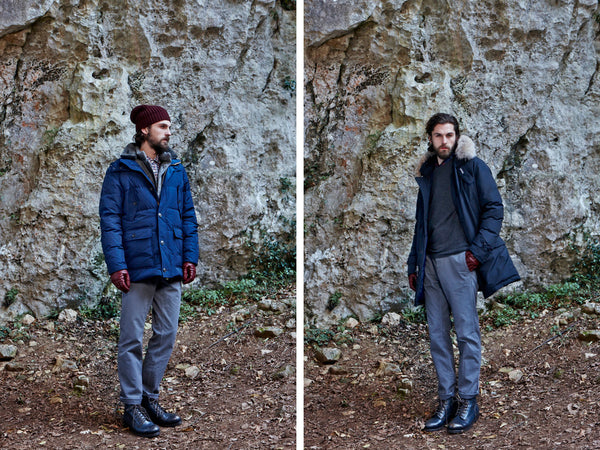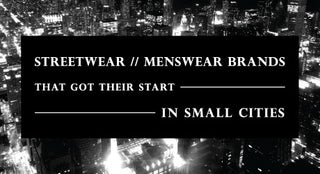A simple perusal of any number of culture websites with a heavy fashion angle reveals a not-so-dirty-little secret about the industry; it’s big city-dominated. Seemingly most, if not all, the brands that get major coverage – whether streetwear or menswear – are either the brainchild of owners from large cities around the world, or actually created and founded in urban metropolises. For anyone who has ever aspired to do anything in the arts, the call of Los Angeles, New York, London, Tokyo, and more seems to be more of an obligation than an allure. While it’s easy to assume that there’s little happening outside of those cities, here are eight brands with vastly different meanings in the marketplace that all have smaller geographical beginnings.
In4mation
The name “In4mation” itself indicates solidarity amongst the owners of the brand – Ryan Arakaki, Todd Shimabuku, Jun Jo, and Keith Kanagusuku – who used the cartoon, Voltron, as a point of inspiration for their moniker. In 2002, the quartet opened a retail space in Mililani, Hawaii. After noticing a growing market of fashion-conscious youth and young adults, they relocated to Honolulu in 2003 for In4mation version 2.
In speaking about the brand’s unique perspective, Jun Jo said, “Being from Hawaii helped a little, but I think it was more of a mindset that we all had at the time. It was a consciousness we had that was influenced from what we were into, which was skating and surfing. Which led to music, then design and concepts.”

Us Versus Them
Even The Hundreds’ own Bobby Hundreds thought Us Versus Them was being held back by their location when he crafted the now infamous list for Complex, The 50 Greatest Streetwear Brands. Saying, “I’ve always said that if Us Versus Them were based in a major city, they’d gain a lot more traction. But I was wrong. Even being anchored in the sleepy California town of Temecula hasn’t held back this label from emerging as the next generation of young streetwear.”
Founded by Mike Glory and Graham Nystrom in 2005, Nystrom said his inspiration stems from, “Those who create something out of nothing, [and] those who can endure hardship and harness that experience into a positive direction.”

Flying Coffin
Seattle brand Flying Coffin’s story can’t be told without recognizing the journey for owner Jason Gomez. Having grown up in Hawaii, he felt it necessary to seek out a new place to create his vision. In speaking with Contrast Magazine, he said, “Our local values and unique culture are lifelong treasures that I take great pride in having as a part of my personality. I really can’t stress that enough. That being said, I found Hawaii a challenging place to live in my later teens to early twenties. The things I cared about most – hardcore, art, and that culture in general – just flat out did not exist there. Hawaii became a very stifling place for me. It was really hard to sit there and know about all of these amazing things happening all over the country and know that I was so far from it, and that I had no chance of being a part of any of it.”
In 2002, Gomez and friends took a road trip that saw them criss-crossing the United States multiple times. When it came time to “go home,” he simply couldn’t. “I was 22 at that point and had done a decent amount of traveling, but never anything on that level,” he said. “The possibilities felt endless. At that point, going back to Hawaii would have been like going to jail. Seattle is a place we spent a fair amount of time in on our trip, and I really fell in love with the city pretty quickly. Moving to Seattle opened me up in ways that I never thought possible. I don’t think I’d be doing what I’m doing if not for the move.”

I Love Ugly
Brands created Down Under are seemingly at a disadvantage due to no other factor than geography. For Auckland’s I Love Ugly, they’re 6,500 miles from Los Angeles and 5,500 miles from Tokyo. Founded by Valentin Ozich and Barnaby Marshall in 2008, in the last 3 years alone, the brand has exploded from a single shop in Central Auckland to stores in Melbourne, West Hollywood, and Wellington.
Thanks to the growth of e-commerce and their idea of bucking the notion that a label needs to only deliver new offerings on a seasonal basis (spring, summer, winter, fall), Marshall said of their success, “In terms of our customer base, it’s just built on itself… mainly through Facebook and friends wearing the clothes.”

Jiberish
What started out as a hobby for founders Dave Boger, Pete Drago, and Gabe Anderson, has evolved into one of the most prominent brands coming out of Denver. When asked about the origins of the company, Drago said, “We just found the invoice from 2004. It was $417. We made 12 sweatshirts and 12 T-shirts that had Jiberish on them. We created the logo and the name. The goal at the beginning was not to start a company per se. We just wanted to make some clothes and bring our own unique perspective from a creative level to an industry and a scene that we thought would be really fun to be a part of. That was really the focus of it from the beginning. As a result, there were a lot of decisions that were made that weren’t financially driven. It was done entirely on what we thought would be cool and what would put the brand in the best position from a connection standpoint.”
Woolrich
It would be hard not to mention some heritage brands that have paved the way for streetwear to succeed in smaller markets. Founded in 1830 in Woolrich, Pennsylvania by John Rich and Daniel McCormick, it has the distinction of being the oldest manufacturer of outdoor wear in the United States.
While its fabrics are legendary, the brand has managed to keep up with modern sensibilities thanks to their notable connection with famed designers Daiki Suzuki of Engineered Garments and Mark McNairy. Woolrich is proof that quality trumps geography.

Carhartt
The very mention of the name “Carhartt” invokes a notion of reliability and durability. While many will point to the rugged construction of the garments, the stability of the family-owned, Dearborn, Michigan-based operation might have something to do with that as well.
Starting with only two sewing machines and five employees, Hamilton Carhartt’s initial attempt in the marketplace was a failure, but he was undeterred by his lack of success. Under the motto “Honest value for an honest dollar,” the Carhartt union-made bib overall was created, and with it, an ideal garment for workers.


